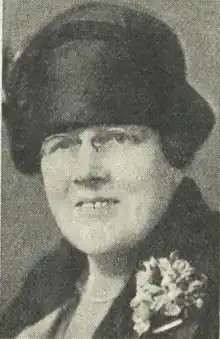Elizabeth Britomarte James
Elizabeth Britomarte James OBE JP (1 June 1867 – 6 November 1943), also known as Mrs Britomarte James, was an Australian political reformer, women's activist and temperance advocate.
Elizabeth Britomarte James OBE, JP | |
|---|---|
 James in 1927 | |
| Born | 1 June 1867 Durban Lead, Ballarat, Victoria, Australia |
| Died | 6 November 1943 (aged 76) Auburn, Victoria, Australia |
| Resting place | Springvale Cemetery |
| Other names | Mrs Britomarte James |
| Known for | Australian political reformer, women's activist and temperance advocate |
Early life and marriage
Born on the Victorian goldfields at Durban Lead, Ballarat, Victoria, James was the eldest child of Ebenezer James and Clara Elizabeth James (née Maisey).[1] The family moved to Port Melbourne where James assisted her father in his work as chaplain at the Mission to Seaman.[2]
James married her cousin, George Henry James on 25 May 1889 at her parents' home in Port Melbourne.[3] He was a schoolteacher with the Victorian Department of Education.[4]
War and welfare work
Both her sons enlisted in World War I and were injured. James travelled to England to assist their recovery. Subsequently, they enlisted in the Flying Corps and, rather than returning to Australia, she volunteered with the Red Cross.[2] She was later put in charge of a unit of the Women's Army Auxiliary Corps in France.[1]
After the war she formed the Ex-Service Woman's Association and was its president for a number of years.[5] In 1922 she was president of both the Metropolitan branch of the Farmers' Union and the Wattle League.[6] She was also a leading member of the Victorian Women Citizens' Movement and the Victorian branch of the National Council of Women.[5]
James stood unsuccessfully for election to the Council of South Melbourne in 1927.[5]
In 1934 James called a meeting at the Lyceum Club in March 1934 at which she proposed the formation of a Centenary Club, being a place to welcome visitors to Melbourne.[7]
In the 1938 Birthday Honours, James was made an Officer of the Order of British Empire[8] for "social welfare services in the State of Victoria".[9]
Personal
James died at Kareela Private Hospital, Auburn, Victoria on 6 November 1943.[1] She was survived by her two sons, Cecil Holman James and George Ronald James.[10] Her husband had predeceased her in September 1938.[4] She is buried in Springvale Cemetery, Springvale, Victoria.[11][12]
References
- Smart, Judith, "James, Elizabeth Britomarte (1867–1943)", Australian Dictionary of Biography, Canberra: National Centre of Biography, Australian National University, retrieved 1 September 2020
- "In Memoriam". The Dawn. Vol. 26, no. 6. Western Australia. 22 December 1943. p. 4. Retrieved 31 August 2020 – via National Library of Australia.
- "Family Notices". The Argus (Melbourne). No. 13, 429. Victoria, Australia. 8 July 1889. p. 1. Retrieved 1 September 2020 – via National Library of Australia.
- "Obituary COLONEL G. H. JAMES". The Argus (Melbourne). No. 28, 732. Victoria, Australia. 23 September 1938. p. 2. Retrieved 1 September 2020 – via National Library of Australia.
- "Melbourne Chatter", The Bulletin, John Haynes and J.F. Archibald, 48 (2475): 47, 21 July 1927, ISSN 0007-4039
- "Interested in Politics". Evening News. No. 17162. New South Wales, Australia. 20 June 1922. p. 9. Retrieved 1 September 2020 – via National Library of Australia.
- "Melbourne Chatter (7 March 1934)", The Bulletin, John Haynes and J.F. Archibald, 55 (2821): 37, 7 March 1934, ISSN 0007-4039
- "BIRTHDAY HONOURS". The West Australian. Vol. 54, no. 16, 206. Western Australia. 9 June 1938. p. 20. Retrieved 31 August 2020 – via National Library of Australia.
- "No. 34518". The London Gazette (Supplement). 7 June 1938. p. 3702.
- "Family Notices". The Age. No. 27629. Victoria, Australia. 8 November 1943. p. 5. Retrieved 31 August 2020 – via National Library of Australia.
- "PERSONAL". The Herald (Melbourne). No. 20, 743. Victoria, Australia. 9 November 1943. p. 7. Retrieved 31 August 2020 – via National Library of Australia.
- "Celebrating our notable humanitarians at SMCT". Southern Metropolitan Cemeteries Trust. Retrieved 1 September 2020.
External links
- My Personal Reminiscences of the War, by Britomarte James
- Transcript of her reminiscences, State Library of New South Wales